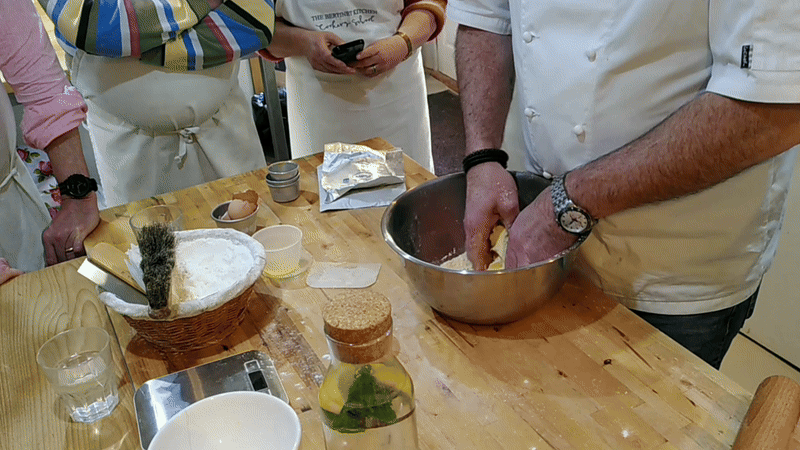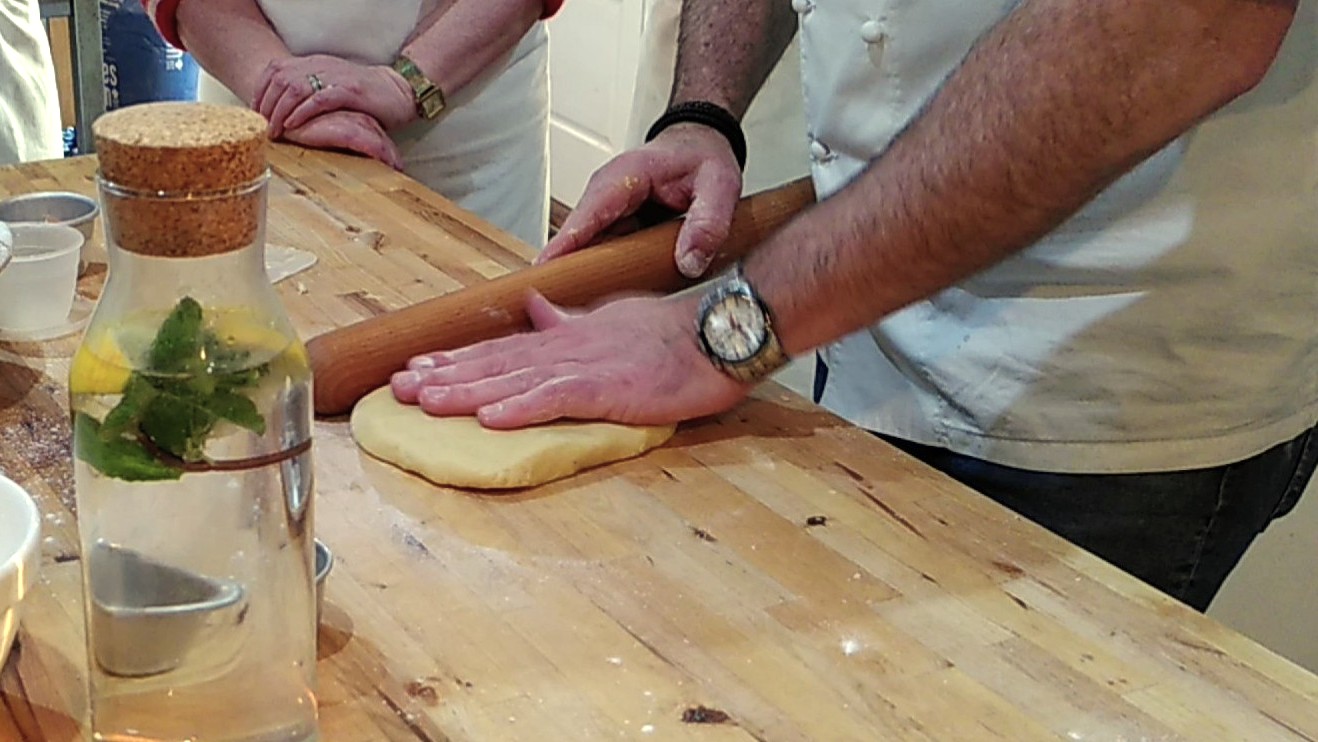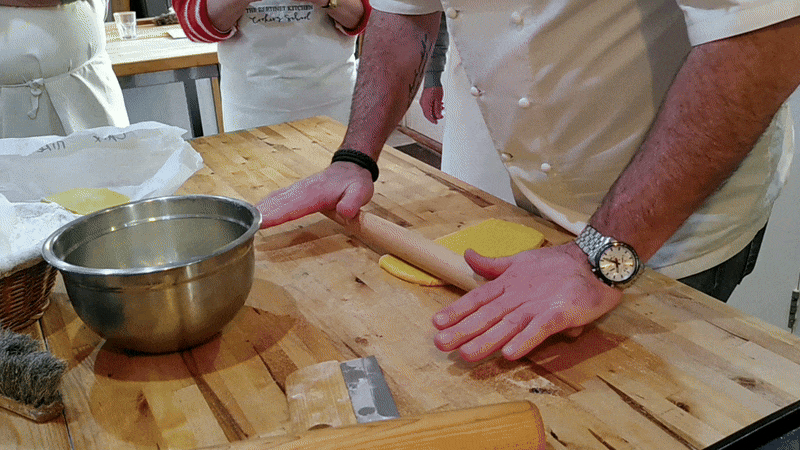If you think you know pies, prepare to have your world rocked.
Earlier this week, I was given the opportunity to take part in a baking class at the Bertinet Kitchen Cookery School. Faced with a list of tempting options, from an introduction to bread-making to croissants and patisserie, one stood out to me: Perfectly Proper Pies.
I hail from a UK town called Wigan, home of the World Pie Eating Championship, where hungry competitors from around the world gather to wolf down as many chunks of meat, potato and pastry as possible. I thought I knew a thing or two about the subject, but it turns out, I was very wrong.
The class took place at the cookery school in Bath, which was recently refitted with new Hotpoint ovens and stoves. The class was led by French baker and chef Richard Bertinet himself. Richard is extremely knowledgeable, drily funny, and a great teacher who takes a practical approach, demonstrating every step of each recipe and having learners repeat it themselves, only giving them a printed copy right at the end so they can’t fall back on using it as a crutch.
There were 12 learners in the class, so we got plenty of face-to-face time with Richard. We were split into three groups of four, and I was delighted to find that one lady in my group took part in the Great British Bake Off (aka the Great British Baking Show) a few years ago. Maggie is just as lovely in person as she was in the tent, and this time had no unfortunate incidents involving flour.
Throughout the day, Richard showed us how to make hand-raised pork pies with hot water pastry, chicken and tarragon pies, and Cornish pasties. All turned out delicious and I learned a huge amount, but it was his advice on making shortcrust pastry that really opened my eyes – and will hopefully save me from ever making anything tough or dry again.
You don’t need to cube your butter
The vast majority of shortcrust pastry recipes I’ve encountered stipulate that you should start with chilled butter, and cut it into cubes before rubbing it into the flour. It’s always a bit tricky – cubing the butter is a hassle if you’re doing it finely, and the cubes tend to melt in your hands as you rub. Instead, Richard Bertinet recommends using a rolling pin to soften the butter without warming it, and not cutting it at all.
Next time you finish a block of butter, keep the wrapper in the fridge. Then, when you want to make pastry, place your weighed butter in between two wrappers and hit it repeatedly with your rolling pin to flatten it. Once it’s the same size as the butter wrappers, it will be soft and malleable, but still cold.
Now drop the butter into your bowl of flour to coat it, and tear it into pieces. It’s easy, there’s no cutting involved, and it’s not going to melt.

You’re probably rubbing wrong
When you rub butter into flour for pastry, do you tend to hunch over the bowl and rub your thumbs against your fingers in circles? There’s a better way. Richard had us step back from our bowls a little (we all instinctively hunched over them) and use an outward pushing action to rub the ingredients together more gently.
He also recommended forgetting anything we’d been told about achieving the texture of ‘fine breadcrumbs’. By the time you’ve done that, the butter will be melted. Instead, flakes about the size of your little fingernail are fine. The butter doesn’t need to completely disappear.
If you prefer, you can use a stand mixer or food processor instead. The cookery school boasted a row of KitchenAid Artisan mixers, and Richard recommends using the flat paddle attachment for pastry. (If you’ve been thinking about investing in a mixer, take a look at our list of KitchenAid discount codes.)
Even the best food processor can easily turn pastry into a greasy ball if you’re not careful, but you can still get good results if you make careful use of the pulse button so the flour is lifted then mixed, lifted then mixed. If you’re using a food processor then I’m afraid you will need to dice your butter, but since you’re not using your hands, it won’t melt.

Knead without speed
Flakiness achieved, it was time to add egg and water, then knead the pastry to a uniform color. We did this without adding extra flour to the work surface – add too much flour and the pastry dries out, meaning you have to add more liquid, and before long you’ve accidentally changed the recipe.
Rather than leaving us to pummel our pastry, Richard had us stand away from the work surface, place one foot in front of the other, and use a full-body rocking motion to knead the dough, aiming to keep it rectangular at all times. I found it tricky not to dig in my thumbs, which made it look like I was trying to sculpt a silly face, but eventually I got the hang of it. Push the pastry forward, fold it, then turn it upside down and repeat. It’s not fast, but it avoids building up too much gluten and making your pastry tough.
When it’s done, it should be nice and smooth, not at all sticky, and sit in a neat block with no ragged edges.

Roll with it
When it was time to roll out our pastry, Richard demonstrated the right amount of flour to use (a tiny dash, thrown over the work surface with panache) and the wrong amount (an untidy heap that looked exactly like what I’d usually dump on my worktop). Whoops.
Again, we were advised not to hunch over the pastry. Instead, we we used the same rocking motion as before, placing only light pressure on the rolling pin and using it to gently push the pastry forward. I had a tendency to lean on the pin in an effort to flatten it faster, but it really doesn’t work like that, and leaning on it will encourage the pastry to stick to the pin and the counter.
For me, the real game-changer was Richard’s technique of making sure the pastry always glides over the worktop. After each rocking motion with your body, slide the pastry and turn it a few degrees. By keeping it moving, you ensure it doesn’t get stuck and don’t need to mess up the recipe by adding flour.
Try it – I think you’ll be pleasantly surprised.

